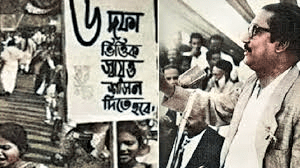In the 1970 National Assembly elections, the mandate of Sheikh Mujib-ur-Rahman’s Awami League Party was based on a Six-Point Program of regional autonomy in a federal Pakistan. Sheikh Mujib-ur-Rahman had presented the Six-Point Program as the constitutional solution of East Pakistan’s problems, in relation to West Pakistan.
First enunciated on February 12, 1966, the six points are as below:
- The Constitution should provide for a Federation of Pakistan in the true sense on the basis of the Lahore Resolution and for a parliamentary form of government based on the supremacy of a directly elected legislature on the basis of universal adult franchise.
- The Federal Government shall deal with only two subjects; Defense and Foreign Affairs. All residuary subjects will be vested in the federating states.
- There should be either two separate, freely convertible currencies for the two Wings, or one currency with two separate reserve banks to prevent inter-Wing flight of capital.
- The power of taxation and revenue collection shall be vested in the federating units. The Federal Government will receive a share to meet its financial obligations.
- Economic disparities between the two Wings shall disappear through a series of economic, fiscal, and legal reforms.
- A militia or paramilitary force must be created in East Pakistan, which at present has no defense of it own.
After the elections of 1970, differences arose between the Government and Awami League on the transfer of power on the basis of this Six-Point Program.
There ensued a political deadlock with talks ending in failure and postponement of the first session of the National Assembly. The postponement of the National Assembly session triggered a chain of events that eventually led to the separation of East Pakistan.
This article was last updated on Sunday, June 01, 2003






